Functional Reactive Programming / Compositional Event Systems
- 1. Taming Asynchronous Workflows with Functional Reactive Programming EuroClojure - Kraków, 2014 Leonardo Borges @leonardo_borges www.leonardoborges.com www.thoughtworks.com
- 2. About ‣ ThoughtWorker ‣ Functional Programming & Clojure advocate ‣ Founder of the Sydney Clojure User Group ‣ Currently writing “Clojure Reactive Programming”
- 3. Taming Asynchronous Workflows with Functional Reactive Programming
- 4. Taming Asynchronous Workflows with Functional Reactive Programming Compositional Event Systems
- 8. There are only two hard things in Computer Science: cache invalidation and naming things. - Phil Karlton :)
- 9. Ok, so what’s the difference?
- 10. ‣ Created in 1997 by Conal Elliott for the reactive animations framework Fran, in Haskell ‣ Since then other implementations have appeared: reactive-banana, NetWire, Sodium (all in Haskell) ‣ And then FRP-inspired ones: Rx[.NET | Java | JS], Baconjs, reagi (Clojurescript) ‣ Main abstractions: Behaviors e Events More about FRP
- 11. ‣ Created in 1997 by Conal Elliott for the reactive animations framework Fran, in Haskell ‣ Since then other implementations have appeared: reactive-banana, NetWire, Sodium (all in Haskell) ‣ And then FRP-inspired ones: Rx[.NET | Java | JS], Baconjs, reagi (Clojure[script]) ‣ Main abstractions: Behaviors e Events ‣ Traditionally defined as: type Behavior a = [Time] -> [a]! type Event a = [Time] -> [Maybe a] More about FRP
- 12. We’ll be focusing on Compositional Event Systems
- 13. Prelude
- 14. Imperative programming describes computations as a series of actions which modify program state var result = 1;! numbers.forEach(function(n){! if(n % 2 === 0) {! result *= n;! }! });! console.log( result );! // 8! var numbers = [1,2,3,4,5]; Requires a variable to store state
- 15. var result = 1;! numbers.forEach(function(n){! if(n % 2 === 0) {! result *= n;! }! });! console.log( result );! // 8! var numbers = [1,2,3,4,5]; We iterate over the array Imperative programming describes computations as a series of actions which modify program state
- 16. var result = 1;! numbers.forEach(function(n){! if(n % 2 === 0) {! result *= n;! }! });! console.log( result );! // 8! var numbers = [1,2,3,4,5]; And then we filter the items… Imperative programming describes computations as a series of actions which modify program state
- 17. var result = 1;! numbers.forEach(function(n){! if(n % 2 === 0) {! result *= n;! }! });! console.log( result );! // 8! var numbers = [1,2,3,4,5]; …and perform the multiplication in the same function Imperative programming describes computations as a series of actions which modify program state
- 18. (def numbers [1 2 3 4 5])! ! (def result! (->> numbers! (filter even?)! (reduce *)))! ! (prn result)! ! ;; 8 In functional programming, we describe what we want to do but not how we want it done
- 19. That is, there are no variables with local state and we get better re-use from single purpose functions
- 20. Compositional Event Systems brings the same principle to values we work with daily: DOM events (clicks, key presses, mouse movement), Ajax calls…
- 21. Let’s look at an example
- 22. Game movements in Javascript var JUMP = 38, CROUCH = 40,! LEFT = 37, RIGHT = 39,! FIRE = 32;! ! function goRight (){! $(‘h1').html("Going right...");! }! ! function goLeft (){! $(‘h1').html("Going left...");! }! ! function jump (){! $('h1').html("Jumping...");! }! ! function crouch (){! $('h1').html("Crouching...");! }! ! function fire (){! $('h1').html("Firing...");! }
- 23. Game movements in Javascript $(window.document).keyup(function(event){! switch(event.keyCode){! case JUMP :! jump();! break;! case CROUCH:! crouch();! break;! case LEFT :! goLeft();! break;! case RIGHT :! goRight();! break;! case FIRE :! fire();! break;! };! });
- 24. We now have limitations similar to the multiplication example
- 25. Let us think key presses as a list of keys over a period of time
- 26. This leads to the following solution
- 27. Reactive game movements (def UP 38) (def RIGHT 39)! (def DOWN 40) (def LEFT 37)! (def FIRE 32) (def PAUSE 80)! ! ! (def source (.fromEvent js/Rx.Observable js/window "keyup"));! ! (-> source (.filter #(= UP %)) (.subscribe jump))! (-> source (.filter #(= DOWN %)) (.subscribe crouch))! (-> source (.filter #(= RIGHT %)) (.subscribe go-right))! (-> source (.filter #(= LEFT %)) (.subscribe go-left))! (-> source (.filter #(= FIRE %)) (.subscribe fire))! http://bit.ly/rxjava-github http://bit.ly/rxjs-github
- 28. Reactive game movements (def UP 38) (def RIGHT 39)! (def DOWN 40) (def LEFT 37)! (def FIRE 32) (def PAUSE 80)! ! ! (def source (.fromEvent js/Rx.Observable js/window "keyup"));! ! (-> source (.filter #(= UP %)) (.subscribe jump))! (-> source (.filter #(= DOWN %)) (.subscribe crouch))! (-> source (.filter #(= RIGHT %)) (.subscribe go-right))! (-> source (.filter #(= LEFT %)) (.subscribe go-left))! (-> source (.filter #(= FIRE %)) (.subscribe fire))! http://bit.ly/rxjava-github http://bit.ly/rxjs-github
- 29. Behaviours ;; behavior examples! (def time-b (r/behavior (System/currentTimeMillis)))! @time-b! ;; 1403691712988! @time-b! ;; 1403691714156! http://bit.ly/reagi
- 30. Behaviours to Event Streams http://bit.ly/reagi (def time-e (r/sample 1000 time-b))! ! (->> time-e (r/map println))! ;; t + 1 sec! ;; 1403692132586! ;; t + 2 sec:! ;; 1403692133587!
- 31. Combinators (-> (Observable/return 42)! (.map #(* % 2))! (.subscribe println))! ! ;; 84! ! (-> (Observable/from [10 20 30])! (.map #(* % 2))! (.reduce +)! (.subscribe println))! ! ;; 120!
- 32. Combinators: flatMap / selectMany (defn project-range [n]! (Rx.Observable/return (range n)))! ! (-> (Observable/from [1 2 3])! (.selectMany project-range)! (.subscribe (rx/fn* println)))! ! ;; 0! ;; 0! ;; 1! ;; 0! ;; 1! ;; 2!
- 33. ?
- 34. (Observable/from [1 2 3]) 1 2 3
- 35. (-> (Observable/from [1 2 3])! (.selectMany project-range)! …) (project-range 2) 0 1 (project-range 1) 0 (project-range 3) 0 1 2 0 0 1 0 1 2
- 36. What about network IO? ‣ Callback hell :( ‣ Clojure promises don’t compose ‣ Promises in JS are slightly better but have limitations ‣ They work well for a single level of values ‣ However are a poor composition mechanism ‣ What if we have a series of values that changes over time?
- 37. Demo: Simple polling app
- 38. This is what the server gives us {:id 7! :question "Which is the best music style?"! :results {:a 10! :b 47! :c 17}}!
- 39. And this is what we want ‣ Render results ‣ Continuously poll server every 2 secs ‣ If current question is the same as the previous one update results; Otherwise: ‣ Stop polling; ‣ Display countdown message; ‣ Render new question and results; ‣ Restart polling;
- 40. The core idea
- 41. First, we need to turn the results into a stream 4 3 3 2 1 1
- 42. So we duplicate the stream, skipping one element 4 3 3 2 1 1 5 4 3 3 2 1 (skip 1)
- 43. Finally, we zip the streams 4 3 3 2 1 1 5 4 3 3 2 1 zip [5,4] [4,3] [3,3] [3,2] [2,1] [1,1]
- 44. The core idea, in code (defn results-observable! "Returns an Observable that yields server-side questions/results"! []! (.create js/Rx.Observable! (fn [observer]! (srm/rpc! (poll-results) [resp]! (.onNext observer resp))! (fn [] (.log js/console "Disposed")))))
- 45. The core idea, in code (def results-connectable! "Zips results-observable with itself, but shifted by 1.! This simulates a 'buffer' or 'window' of results"! (let [obs (-> js/Rx.Observable! (.interval 2000)! (.selectMany results-observable)! (.publish)! (.refCount))! obs-1 (.skip obs 1)]! (.zip obs obs-1 (fn [prev curr]! {:prev prev! :curr curr}))))! Turn results into a stream
- 46. The core idea, in code (def results-connectable! "Zips results-observable with itself, but shifted by 1.! This simulates a 'buffer' or 'window' of results"! (let [obs (-> js/Rx.Observable! (.interval 2000)! (.selectMany results-observable)! (.publish)! (.refCount))! obs-1 (.skip obs 1)]! (.zip obs obs-1 (fn [prev curr]! {:prev prev! :curr curr}))))! Clone stream, skip one
- 47. The core idea, in code (def results-connectable! "Zips results-observable with itself, but shifted by 1.! This simulates a 'buffer' or 'window' of results"! (let [obs (-> js/Rx.Observable! (.interval 2000)! (.selectMany results-observable))! obs-1 (.skip obs 1)]! (.zip obs obs-1 (fn [prev curr]! {:prev prev! :curr curr}))))! Zip them together
- 48. Can we do better?
- 49. Buffering (def results-buffer! "Returns an Observable with results buffered into a 2-element vector"! (-> js/Rx.Observable! (.interval 2000)! (.selectMany results-observable)! (.bufferWithCount 2)))!
- 50. Live Demo
- 51. "FRP is about handling time-varying values like they were regular values" - Haskell Wiki
- 52. "FRP is about handling time-varying values like they were regular values" - Haskell Wiki It also applies to FRP-inspired systems
- 53. Why not use core.async?
- 54. Previously, with CES (-> (Observable/from [10 20 30])! (.map (rx/fn [v] (* v 2)))! (.reduce (rx/fn* +)! (.subscribe (rx/fn* println)))))
- 55. With core.async (defn from-array [coll]! (let [stream-c (chan)]! (go (doseq [n coll]! (>! stream-c n))! (close! stream-c))! stream-c))! ! (def c (->> (async-from [10 20 30])! (a/map< #(* % 2))! (a/reduce + 0)))! ! (go-loop []! (when-let [v (<! c)]! (println v)! (recur)))!
- 56. Multiple subscribers with CES (def sum-of-squares (-> (Observable/from [10 20 30])! (.map (rx/fn [v] (* v 2)))! (.reduce (rx/fn* +))))! ! ! ! (.subscribe sum-of-squares (rx/action* println)) ;; 120! (.subscribe sum-of-squares (rx/action* println)) ;; 120
- 57. Multiple subscribers with core.async [1/3] (def in (chan))! (def sum-of-squares (->> in! (a/map< #(* % 2))! (a/reduce + 0)))!
- 58. Multiple subscribers with core.async [2/3] (def publication (pub sum-of-squares (fn [_] :n)))! ! (def sub-1 (chan))! (def sub-2 (chan))! ! (sub publication :n sub-1)! (sub publication :n sub-2)
- 59. Multiple subscribers with core.async [3/3] (go (doseq [n [10 20 30]]! (>! in n))! (close! in))! ! (go-loop []! (when-let [v (<! sub-1)]! (prn v)! (recur))) ;; 120! ! (go-loop []! (when-let [v (<! sub-2)]! (prn v)! (recur))) ;; 120
- 60. core.async operates at a lower level of abstraction
- 61. it is however a great foundation for a FRP-inspired framework
- 62. Reagi - shown earlier - is built on top of core.async http://bit.ly/reagi
- 63. Bonus example: a reactive API to AWS
- 64. Bonus example: a reactive API to AWS ‣ Retrieve list of resources from a stack (CloudFormation.describeStackResources) ‣ For each EC2 Instance, call EC2.describeInstances to retrieve status ‣ For each RDS Instance, call RDS.describeDBInstances to retrieve status ‣ Merge results and display
- 65. Step 1: turn api calls into streams (defn resources-stream [stack-name]! (.create js/Rx.Observable! (fn [observer]! (.describeStackResources js/cloudFormation #js {"StackName" : stackName}! (fn [err data]! (if err! (.onError observer err)! (doseq [resource data]! (.onNext observer resource))! (.onCompleted observer)))! (fn [] (.log js/console "Disposed")))))
- 66. Step 1: turn api calls into streams (defn ec2-instance-stream [resource-ids]! (.create js/Rx.Observable! (fn [observer]! (.describeInstaces js/ec2 #js {"InstanceIds" resource-ids}! (fn [err data]! (if err! (.onError observer err)! (doseq [instance data]! (.onNext observer instance)))! (.onCompleted observer)))! (fn [] (.log js/console "Disposed")))))!
- 67. Step 1: turn api calls into streams (defn rds-instance-stream [resource-id]! (.create js/Rx.Observable! (fn [observer]! (.describeDBInstances js/rds #js {"DBInstanceIdentifier" resource-id}! (fn [err data]! (if err! (.onError observer err)! (.onNext observer data))! (.onCompleted observer)))! (fn [] (.log js/console "Disposed")))))
- 68. Step 2: transform the different API responses into a common output (def resources (resourcesStream "my-stack"))! ! (def ec2-data (-> resources! (.filter ec2?)! (.map :resource-id)! (.flatMap ec2-instance-stream)! (.map (fn [data] {:instance-id ...! :status ...}))))! ! (def rds-data (-> resources! (.filter rds?)! (.map :resource-id)! (.flatMap rds-instance-stream)! (.map (fn [data] {:instance-id ...! :status ...}))))!
- 69. Step 3: merge results and update UI (-> ec2-data! (.merge rds-data)! (.reduce conj [])! (.subscribe (fn [data] (update-interface ...))))
- 70. Easy to reason about, maintain and test
- 71. References ! ‣ Conal Elliott “Functional Reactive Animation” paper: http://bit.ly/conal-frp ! FRP-inspired frameworks: ‣ Reagi: http://bit.ly/reagi ‣ RxJS: http://bit.ly/rxjs-github ‣ RxJava: http://bit.ly/rxjava-github ‣ Bacon.js: https://github.com/baconjs/bacon.js ! FRP implementations: ‣ Reactive Banana: http://www.haskell.org/haskellwiki/Reactive-banana ‣ Elm: http://elm-lang.org/ ‣ NetWire: http://www.haskell.org/haskellwiki/Netwire


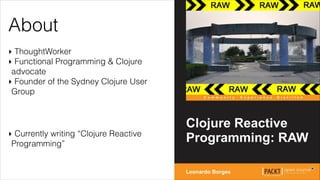
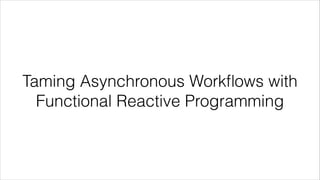



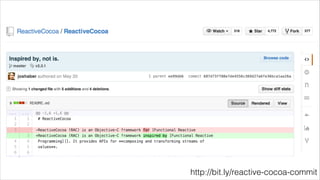


![‣ Created in 1997 by Conal Elliott for the reactive animations framework Fran, in Haskell
‣ Since then other implementations have appeared: reactive-banana, NetWire, Sodium
(all in Haskell)
‣ And then FRP-inspired ones: Rx[.NET | Java | JS], Baconjs, reagi (Clojurescript)
‣ Main abstractions: Behaviors e Events
More about FRP](https://image.slidesharecdn.com/frp-ces-euroclojure-2014-140627053504-phpapp01/85/Functional-Reactive-Programming-Compositional-Event-Systems-10-320.jpg)
![‣ Created in 1997 by Conal Elliott for the reactive animations framework Fran, in Haskell
‣ Since then other implementations have appeared: reactive-banana, NetWire, Sodium
(all in Haskell)
‣ And then FRP-inspired ones: Rx[.NET | Java | JS], Baconjs, reagi (Clojure[script])
‣ Main abstractions: Behaviors e Events
‣ Traditionally defined as:
type Behavior a = [Time] -> [a]!
type Event a = [Time] -> [Maybe a]
More about FRP](https://image.slidesharecdn.com/frp-ces-euroclojure-2014-140627053504-phpapp01/85/Functional-Reactive-Programming-Compositional-Event-Systems-11-320.jpg)


![Imperative programming describes computations as a series of actions
which modify program state
var result = 1;!
numbers.forEach(function(n){!
if(n % 2 === 0) {!
result *= n;!
}!
});!
console.log( result );!
// 8!
var numbers = [1,2,3,4,5]; Requires a variable
to store state](https://image.slidesharecdn.com/frp-ces-euroclojure-2014-140627053504-phpapp01/85/Functional-Reactive-Programming-Compositional-Event-Systems-14-320.jpg)
![var result = 1;!
numbers.forEach(function(n){!
if(n % 2 === 0) {!
result *= n;!
}!
});!
console.log( result );!
// 8!
var numbers = [1,2,3,4,5];
We iterate over the
array
Imperative programming describes computations as a series of actions
which modify program state](https://image.slidesharecdn.com/frp-ces-euroclojure-2014-140627053504-phpapp01/85/Functional-Reactive-Programming-Compositional-Event-Systems-15-320.jpg)
![var result = 1;!
numbers.forEach(function(n){!
if(n % 2 === 0) {!
result *= n;!
}!
});!
console.log( result );!
// 8!
var numbers = [1,2,3,4,5];
And then we filter the
items…
Imperative programming describes computations as a series of actions
which modify program state](https://image.slidesharecdn.com/frp-ces-euroclojure-2014-140627053504-phpapp01/85/Functional-Reactive-Programming-Compositional-Event-Systems-16-320.jpg)
![var result = 1;!
numbers.forEach(function(n){!
if(n % 2 === 0) {!
result *= n;!
}!
});!
console.log( result );!
// 8!
var numbers = [1,2,3,4,5];
…and perform the
multiplication in the
same function
Imperative programming describes computations as a series of actions
which modify program state](https://image.slidesharecdn.com/frp-ces-euroclojure-2014-140627053504-phpapp01/85/Functional-Reactive-Programming-Compositional-Event-Systems-17-320.jpg)
![(def numbers [1 2 3 4 5])!
!
(def result!
(->> numbers!
(filter even?)!
(reduce *)))!
!
(prn result)!
!
;; 8
In functional programming, we describe what we want to do but not
how we want it done](https://image.slidesharecdn.com/frp-ces-euroclojure-2014-140627053504-phpapp01/85/Functional-Reactive-Programming-Compositional-Event-Systems-18-320.jpg)












![Combinators
(-> (Observable/return 42)!
(.map #(* % 2))!
(.subscribe println))!
!
;; 84!
!
(-> (Observable/from [10 20 30])!
(.map #(* % 2))!
(.reduce +)!
(.subscribe println))!
!
;; 120!](https://image.slidesharecdn.com/frp-ces-euroclojure-2014-140627053504-phpapp01/85/Functional-Reactive-Programming-Compositional-Event-Systems-31-320.jpg)
![Combinators: flatMap /
selectMany
(defn project-range [n]!
(Rx.Observable/return (range n)))!
!
(-> (Observable/from [1 2 3])!
(.selectMany project-range)!
(.subscribe (rx/fn* println)))!
!
;; 0!
;; 0!
;; 1!
;; 0!
;; 1!
;; 2!](https://image.slidesharecdn.com/frp-ces-euroclojure-2014-140627053504-phpapp01/85/Functional-Reactive-Programming-Compositional-Event-Systems-32-320.jpg)

![(Observable/from [1 2 3])
1 2 3](https://image.slidesharecdn.com/frp-ces-euroclojure-2014-140627053504-phpapp01/85/Functional-Reactive-Programming-Compositional-Event-Systems-34-320.jpg)
![(-> (Observable/from [1 2 3])!
(.selectMany project-range)!
…)
(project-range 2)
0 1
(project-range 1)
0
(project-range 3)
0 1 2
0 0 1 0 1 2](https://image.slidesharecdn.com/frp-ces-euroclojure-2014-140627053504-phpapp01/85/Functional-Reactive-Programming-Compositional-Event-Systems-35-320.jpg)



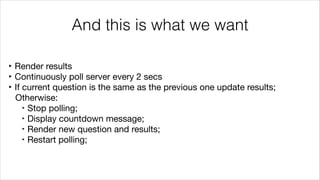

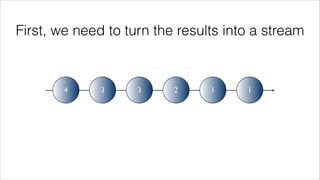

![Finally, we zip the streams
4 3 3 2 1 1
5 4 3 3 2 1
zip
[5,4] [4,3] [3,3] [3,2] [2,1] [1,1]](https://image.slidesharecdn.com/frp-ces-euroclojure-2014-140627053504-phpapp01/85/Functional-Reactive-Programming-Compositional-Event-Systems-43-320.jpg)
![The core idea, in code
(defn results-observable!
"Returns an Observable that yields server-side questions/results"!
[]!
(.create js/Rx.Observable!
(fn [observer]!
(srm/rpc!
(poll-results) [resp]!
(.onNext observer resp))!
(fn [] (.log js/console "Disposed")))))](https://image.slidesharecdn.com/frp-ces-euroclojure-2014-140627053504-phpapp01/85/Functional-Reactive-Programming-Compositional-Event-Systems-44-320.jpg)
![The core idea, in code
(def results-connectable!
"Zips results-observable with itself, but shifted by 1.!
This simulates a 'buffer' or 'window' of results"!
(let [obs (-> js/Rx.Observable!
(.interval 2000)!
(.selectMany results-observable)!
(.publish)!
(.refCount))!
obs-1 (.skip obs 1)]!
(.zip obs obs-1 (fn [prev curr]!
{:prev prev!
:curr curr}))))!
Turn results into a
stream](https://image.slidesharecdn.com/frp-ces-euroclojure-2014-140627053504-phpapp01/85/Functional-Reactive-Programming-Compositional-Event-Systems-45-320.jpg)
![The core idea, in code
(def results-connectable!
"Zips results-observable with itself, but shifted by 1.!
This simulates a 'buffer' or 'window' of results"!
(let [obs (-> js/Rx.Observable!
(.interval 2000)!
(.selectMany results-observable)!
(.publish)!
(.refCount))!
obs-1 (.skip obs 1)]!
(.zip obs obs-1 (fn [prev curr]!
{:prev prev!
:curr curr}))))!
Clone stream, skip
one](https://image.slidesharecdn.com/frp-ces-euroclojure-2014-140627053504-phpapp01/85/Functional-Reactive-Programming-Compositional-Event-Systems-46-320.jpg)
![The core idea, in code
(def results-connectable!
"Zips results-observable with itself, but shifted by 1.!
This simulates a 'buffer' or 'window' of results"!
(let [obs (-> js/Rx.Observable!
(.interval 2000)!
(.selectMany results-observable))!
obs-1 (.skip obs 1)]!
(.zip obs obs-1 (fn [prev curr]!
{:prev prev!
:curr curr}))))!
Zip them together](https://image.slidesharecdn.com/frp-ces-euroclojure-2014-140627053504-phpapp01/85/Functional-Reactive-Programming-Compositional-Event-Systems-47-320.jpg)





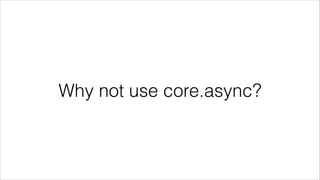
![Previously, with CES
(-> (Observable/from [10 20 30])!
(.map (rx/fn [v] (* v 2)))!
(.reduce (rx/fn* +)!
(.subscribe (rx/fn* println)))))](https://image.slidesharecdn.com/frp-ces-euroclojure-2014-140627053504-phpapp01/85/Functional-Reactive-Programming-Compositional-Event-Systems-54-320.jpg)
![With core.async
(defn from-array [coll]!
(let [stream-c (chan)]!
(go (doseq [n coll]!
(>! stream-c n))!
(close! stream-c))!
stream-c))!
!
(def c (->> (async-from [10 20 30])!
(a/map< #(* % 2))!
(a/reduce + 0)))!
!
(go-loop []!
(when-let [v (<! c)]!
(println v)!
(recur)))!](https://image.slidesharecdn.com/frp-ces-euroclojure-2014-140627053504-phpapp01/85/Functional-Reactive-Programming-Compositional-Event-Systems-55-320.jpg)
![Multiple subscribers with CES
(def sum-of-squares (-> (Observable/from [10 20 30])!
(.map (rx/fn [v] (* v 2)))!
(.reduce (rx/fn* +))))!
!
!
!
(.subscribe sum-of-squares (rx/action* println)) ;; 120!
(.subscribe sum-of-squares (rx/action* println)) ;; 120](https://image.slidesharecdn.com/frp-ces-euroclojure-2014-140627053504-phpapp01/85/Functional-Reactive-Programming-Compositional-Event-Systems-56-320.jpg)
![Multiple subscribers with core.async [1/3]
(def in (chan))!
(def sum-of-squares (->> in!
(a/map< #(* % 2))!
(a/reduce + 0)))!](https://image.slidesharecdn.com/frp-ces-euroclojure-2014-140627053504-phpapp01/85/Functional-Reactive-Programming-Compositional-Event-Systems-57-320.jpg)
![Multiple subscribers with core.async [2/3]
(def publication (pub sum-of-squares (fn [_] :n)))!
!
(def sub-1 (chan))!
(def sub-2 (chan))!
!
(sub publication :n sub-1)!
(sub publication :n sub-2)](https://image.slidesharecdn.com/frp-ces-euroclojure-2014-140627053504-phpapp01/85/Functional-Reactive-Programming-Compositional-Event-Systems-58-320.jpg)
![Multiple subscribers with core.async [3/3]
(go (doseq [n [10 20 30]]!
(>! in n))!
(close! in))!
!
(go-loop []!
(when-let [v (<! sub-1)]!
(prn v)!
(recur))) ;; 120!
!
(go-loop []!
(when-let [v (<! sub-2)]!
(prn v)!
(recur))) ;; 120](https://image.slidesharecdn.com/frp-ces-euroclojure-2014-140627053504-phpapp01/85/Functional-Reactive-Programming-Compositional-Event-Systems-59-320.jpg)





![Step 1: turn api calls into streams
(defn resources-stream [stack-name]!
(.create js/Rx.Observable!
(fn [observer]!
(.describeStackResources js/cloudFormation #js {"StackName" : stackName}!
(fn [err data]!
(if err!
(.onError observer err)!
(doseq [resource data]!
(.onNext observer resource))!
(.onCompleted observer)))!
(fn [] (.log js/console "Disposed")))))](https://image.slidesharecdn.com/frp-ces-euroclojure-2014-140627053504-phpapp01/85/Functional-Reactive-Programming-Compositional-Event-Systems-65-320.jpg)
![Step 1: turn api calls into streams
(defn ec2-instance-stream [resource-ids]!
(.create js/Rx.Observable!
(fn [observer]!
(.describeInstaces js/ec2 #js {"InstanceIds" resource-ids}!
(fn [err data]!
(if err!
(.onError observer err)!
(doseq [instance data]!
(.onNext observer instance)))!
(.onCompleted observer)))!
(fn [] (.log js/console "Disposed")))))!](https://image.slidesharecdn.com/frp-ces-euroclojure-2014-140627053504-phpapp01/85/Functional-Reactive-Programming-Compositional-Event-Systems-66-320.jpg)
![Step 1: turn api calls into streams
(defn rds-instance-stream [resource-id]!
(.create js/Rx.Observable!
(fn [observer]!
(.describeDBInstances js/rds #js {"DBInstanceIdentifier" resource-id}!
(fn [err data]!
(if err!
(.onError observer err)!
(.onNext observer data))!
(.onCompleted observer)))!
(fn [] (.log js/console "Disposed")))))](https://image.slidesharecdn.com/frp-ces-euroclojure-2014-140627053504-phpapp01/85/Functional-Reactive-Programming-Compositional-Event-Systems-67-320.jpg)
![Step 2: transform the different API
responses into a common output
(def resources (resourcesStream "my-stack"))!
!
(def ec2-data (-> resources!
(.filter ec2?)!
(.map :resource-id)!
(.flatMap ec2-instance-stream)!
(.map (fn [data] {:instance-id ...!
:status ...}))))!
!
(def rds-data (-> resources!
(.filter rds?)!
(.map :resource-id)!
(.flatMap rds-instance-stream)!
(.map (fn [data] {:instance-id ...!
:status ...}))))!](https://image.slidesharecdn.com/frp-ces-euroclojure-2014-140627053504-phpapp01/85/Functional-Reactive-Programming-Compositional-Event-Systems-68-320.jpg)
![Step 3: merge results and update UI
(-> ec2-data!
(.merge rds-data)!
(.reduce conj [])!
(.subscribe (fn [data] (update-interface ...))))](https://image.slidesharecdn.com/frp-ces-euroclojure-2014-140627053504-phpapp01/85/Functional-Reactive-Programming-Compositional-Event-Systems-69-320.jpg)


